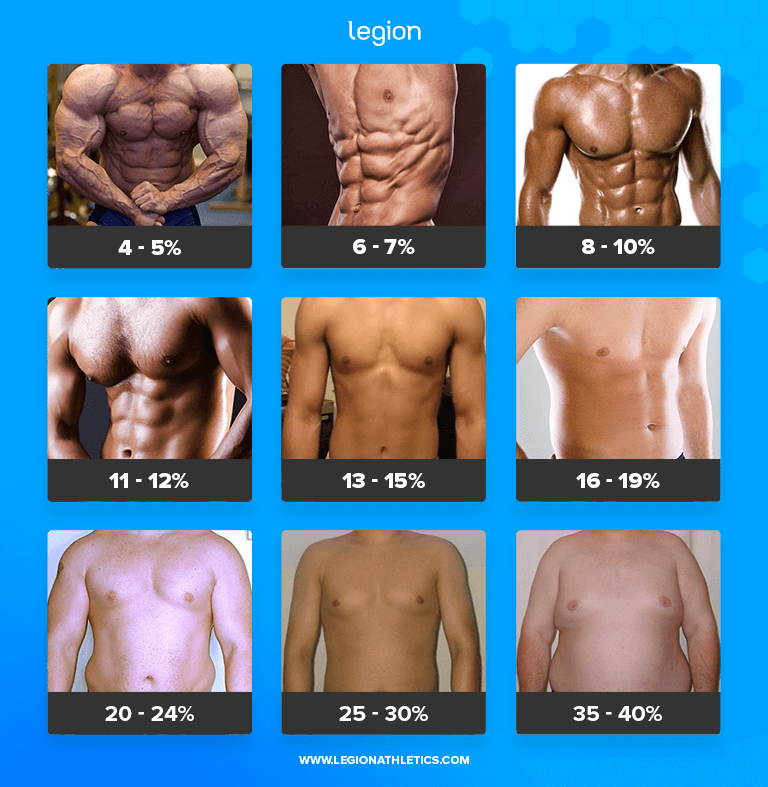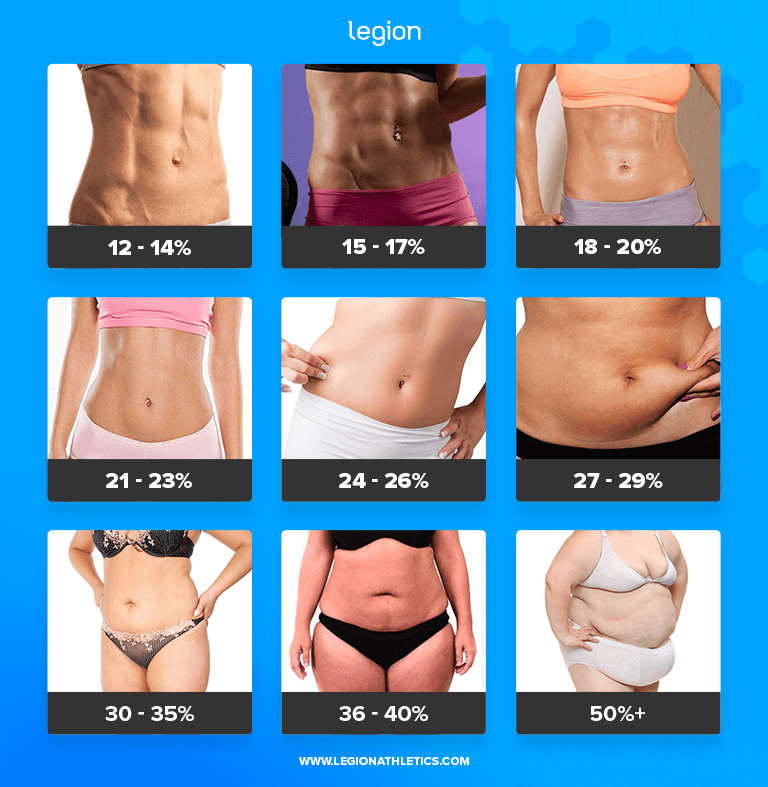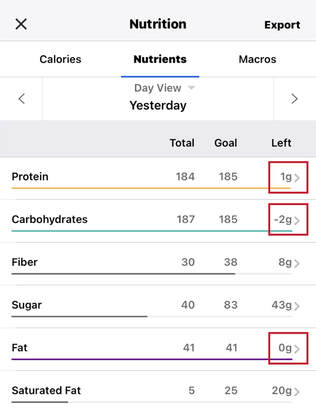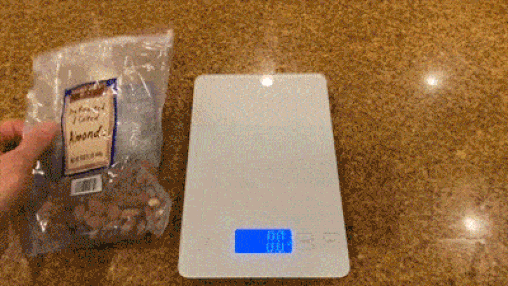|
You have probably heard the term “Counting Macros” before. You know someone in super good shape always talking about macros, but what does it mean? How do they do it? Is it just another one of those fad diets that probably will fail you like all the others?
Counting Macros is Not "A Diet"
When you are counting macros, you are dieting, but not "following a diet" per se. You are encouraged to make healthy choices, avoid processed foods and focus on fresh foods rich in vitamins. If you struggle with hunger (like me) limiting foods that are high in "empty calories" (like candy, chips, etc) is your ticket to fullness while restricting calories!
While there is much debate in the nutrition industry about just about everything, one golden rule stands out as being generally recognized by all the leading minds; eating more calories than you burn makes you gain weight and eating fewer calories than you burn makes you lose weight. So if that is true, why do we care what comprises the calorie we consume? If we eat the wrong balance of macronutrients, especially while restricting calories, we can end up with hunger spikes, low energy, and muscle loss (instead of fat loss.) It is common for people to say they want to "lose weight" or "shed a few pounds", but their focus is misguided. If you were in the greatest shape of your life but the scale stayed the same, you'd be thrilled, right? So let's change our focus from just "losing weight" to burning fat and building muscle. If we have the right macronutrient breakdown, we can lose fat quickly while maintaining or even building muscle at the same time! Calculate Your Macros
The first thing you need to calculate your macros is to estimate your body fat percentage. Some macro calculators do not require your body fat percentage, but instead, they estimate it in the back-end based on your height, weight, and biological sex. Although it is almost impossible to accurately estimate your body-fat percentage, your best guess will likely give you better results than other methods. There are all sorts of electronic body fat measuring devices ranging from $20 to thousands of dollars and all sorts of formulas, but most can end up being about as accurate as just guessing by comparing example images to your mirror. My recommendation is to look at the images below and take your best guess.
These images came from this awesome article How to Calculate Body Fat Percentage from Legion Athletics, which goes much more into detail about body fat percentage methods. If you want to learn more about this important metric, I recommend giving it a read and even doing additional research.
Once you have your body fat percentage down, you can calculate your macros with this calculator below:
Now that you have your macros, it's time to plan your meals around them. MyFitnessPal is the most popular macro counting app used by bodybuilders and it's easy to use once you get the hang of it. It is perfectly ok if you prefer a different app or method, but the rest of this article will mostly focus on the MyFitnessPal app.
Set Up MyFitnessPal
Daily Habits
Now that you know how to set calculate your macros, you need to work on the skills of effective meal planning. Get comfortable with the app and plan out your first three days of eating before starting. It can be tricky at first finding the right foods that fit your macros, but it gets easier!
This is usually how it goes for beginners: Week 1: Wow, this is a lot of work Week 2: This sucks Week 3: It’s not so bad, but it doesn’t seem to be doing much Week 4 progress photo: OMG, that first photo was me?! That was not as hard as I thought it would be! The Checkmark Fitness Golden Rule of Dieting
Above everything else, when it comes to dieting there is one golden rule that must always be followed:
Never eat foods you don't like and eat foods you love every day! One of the most common reasons people quit their diet is because they are eating foods they don't like. Counting macros forever is unrealistic for most people. It works as a short term 8-16 week cut once a year, but once you lose the fat you want your lifestyle to be conducive to keeping it off. If you even make it through the cut eating foods you don't like, you will almost certainly drop those habits when you are no longer tracking. Eating foods you love does not mean if you love Taco Bell to eat Taco Bell to eat taco bell every day. Alternatively, you should find the healthy foods you like and make sure you make it a priority to have them on hand. Strawberries, almonds, lean steak, whatever it is, everyone has some healthy foods they love. Discover your favorites and dieting won't feel so hard. Hunger
One of the main reasons people quit their diet is hunger. There are a few simple diet hacks that help you restrict calories while avoiding hunger altogether. If you do all of these daily, you can do a lot to feel full while dieting:
What are Processed Foods?
Technically processed foods are foods that have been changed in any way since leaving the farm. When we refer to processed foods I am not referring to this literal definition. Baby carrots, frozen peas, and even washed strawberries fit the technical description of processed food. When we mention processed foods we are talking about foods that have multiple ingredients you can not see. Things like chips, bread, juice, lean pockets, canned soup, etc. It’s not to say that all processed food are bad, but as a general rule of thumb, they are often the less optimal choice. Some processed foods like frozen, canned, or dried fruits and vegetables without added ingredients are usually nutritionally equivalent to the fresh stuff.
Some high-protein processed foods, while still not the best choice, can fit into your daily meal plan easily and can be worth the exception. Things like protein bars (with at least 35% protein), 0% greek yogurt, beef jerky, and protein powder can help make your life a little easier. Low calorie "diet foods" are generally not recommended, but when eaten in moderation (less than 10% of you daily calories) can be a great little snack to make dieting more fun. Things like sugarfree Jello, Halo Top Ice Cream, and Quest Protein chips are not too bad on the macros. Protein
Most people do not eat enough protein in their diet in general. If you set the macro calculator to "cut", you will probably have to eat a lot more protein than you are used to. You should start planning your meals around foods that are protein heavy. Here are some examples:
Carbohydrates
The whole concept of low-carb being good for you is a myth. Carbs help give you energy throughout the day. All carbs fall on a range of 1-100 called the glycemic index. You can see some foods on this index here or Google a specific carb with the term "glycemic index" to find out where it falls on the index. You want to fill your diet with healthy low-glycemic carbs (55 or less) throughout the day. Things like broccoli, tomatoes, onions, apples, oranges, strawberries, chickpeas, peas, and sweet potatoes are great carbs to keep you full and energized all day long!
Foods high on the glycemic index (above 70) should be mostly limited with one big exception; right before and after you do a strength-training activity. Healthy high-glycemic foods like potatoes, white rice, rice cakes, and even gummy bears can be a great way to give you energy before your workout and restore the glycogen in your muscles after your workout. Fat
Eating fat does not make you fat.
Eating fat does not make you fat. Eating fat does not make you fat. Overeating calories makes you fat. Your body does not care whether you are over-consuming protein, carbs, or fat - if you over-eat, you will gain weight. This myth often gets tossed around because fat (the macronutrient) is calories than carbs or protein. If you cook half a pound of onions in just two tablespoons of olive oil, 73% of the calories come from the just the olive oil! The fat from olive oil may be good for you, but all those calories add up quickly! This extreme caloric density difference is what causes a lot of people to feel like they do not eat much yet can not lose weight. When counting your macros always do your best to estimate your protein and carbs, but it is important to measure your fat quantities as accurate as possible. There is a lot to get into with the different types of fats, but as a general rule of thumb; you want to try to focus on getting most of your fat from unsaturated fat sources. Things like nuts, seeds, some oils, and avocado are considered "healthy" fats. Weighing and Tracking
"Do I have to weigh everything I eat?" is a question I get often. Personally, I weigh everything I can while cutting not because the accuracy is super important, but because it is actually easier. I find it can be faster than trying to guess the amount of a certain food or ingredient. Food scales are cheap and easy to use. The Raymeefa Digital Food Scale is a good one. It might not be a bad idea to get one for home and one for work.
Weighing trick: The Reverse Tare - This trick can be useful to make measuring some food easier. You measure the amount you are taking off the scale instead of the weight you are putting on the scale.
Copying Days
You do not need to start from scratch every day. With MyFitnessPal, you can copy any item, an entire meal, or even an entire day! It can make your life a lot easier to have 2-4 balanced days that you just copy and modify instead of making an entirely new meal plan every day.
To copy an item, you go to DIARY >> find the day you want to copy from >> EDIT (on the top left) >> Select All to copy the entire day or the name of a meal to copy just that meal >> COPY >> then just select the day or meal you want to copy it to. Stabilizer Macros
It can be tricky to stick to specific amounts of foods throughout the day. Getting close and rounding out the day with stabilizer macros is an easy trick to make it a little easier. Just plan on ending your day with a source of protein, carbs, and fat that you can easily modify. One example would be to have a little snack or meal of 0% Greek yogurt, strawberries, and almonds at the end of the day. All these food are super easy to get specific with. You do your best matching what you planned, but when your chicken breast for lunch turned out to be 8oz instead of 10oz and your apple snack was 6oz instead of 4oz, you just adjust those numbers in the app. Then at the end of the day, you modify your stabilizers before you grab them. With a scale, it is easy to make sure you get exactly 2.4oz of almonds or 11.2oz of greek yogurt!
You are Ready to Count Macros Like a Pro!
I hope you found this guide useful. There is a lot I did not cover. I tried to keep things simple, practical, and actionable. If you want a more hands-on approach to your nutrition, I recommend hiring a Registered Dietitian who can help make a meal plan more tailored to your needs.
If you want to join a community of people helping each other stick to their fitness goals, you can join Checkmark Fitness!
Have any questions or other tips for counting macros? Leave a comment below!
0 Comments
Leave a Reply. |
Alexander SimoneJust trying to help people get in shape! |






